Pigeon Loft Ventilation
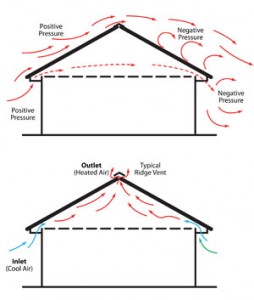 Even if one whole side of your loft was open, you would not have good ventilation. In fact, you would have quite a draft and probably would get sick pigeons. How do you have good ventilation and yet not have drafts blowing on the birds? How can you have good ventilation without allowing your birds to get wet because you had the windows open? Why do you even have to have good ventilation? These are some good questions. They are also very important ones that most people over look. They are also reasons why many fanciers do not race as well as they could.
Even if one whole side of your loft was open, you would not have good ventilation. In fact, you would have quite a draft and probably would get sick pigeons. How do you have good ventilation and yet not have drafts blowing on the birds? How can you have good ventilation without allowing your birds to get wet because you had the windows open? Why do you even have to have good ventilation? These are some good questions. They are also very important ones that most people over look. They are also reasons why many fanciers do not race as well as they could.
First of all, pigeons breathe out carbon dioxide just like you do. They need oxygen to be healthy and filled with energy. They also have their droppings land on the floor. These droppings contain ammonia. In large quantities ammonia will burn the linings of your nose and lungs. It also makes your eyes water. Your body does not want it or like it. Besides, it smells. It is much worse during damp weather because the droppings do not get a chance to dry out.
The carbon dioxide and the ammonia have to go. If they don’t , your pigeons will not perform their best. Most fanciers do not understand what good ventilation is. They feel that a window or two will take care of their needs. It is true that a window or two helps. In fact the windows are necessary, but heir main purpose of the windows should be to allow light to enter the loft. When the weather is nasty, those windows should be closed. It they are not, rain or snow will enter the loft and will dampen the floor and droppings. The damp floor as well as the damp droppings will soon cause your pigeons to become ill.
Proper ventilation is used in rain or shine. It is used in winter or summer. It is especially useful on days when there is no breeze. Proper ventilation begins either on the roof, of at the top of the highest wall. The pigeons produce body heat. The sun beating down on the loft also produces heat. The warm air rises. As it rise, it leaves from the ventilators in the roof or eaves. The second part of proper ventilators is to speed up the process of getting the warm air out. This is done by replacing it with cooler air. Cooler air is heavier than warm air. The bottom of the loft should have a ventilator vent on the bottom of the wall. It should be on the same wall as the top ventilator. In this way, cool oxygen filled air enters the loft at the bottom. As it leaves, it takes the carbon dioxide and ammonia with it. Simple isn’t it? It is also cheap. The results are wonderful. Your birds will be healthier and perform better. They will also not be in a draft, and the system works every day of the year, regardless hat the weather does. If you want to see if your system is adequate, you can do this test. Take something smelly, like air freshener, into your loft. Come back ten minutes later. It you can still smell the odor, then add another roof ventilator and floor ventilator.

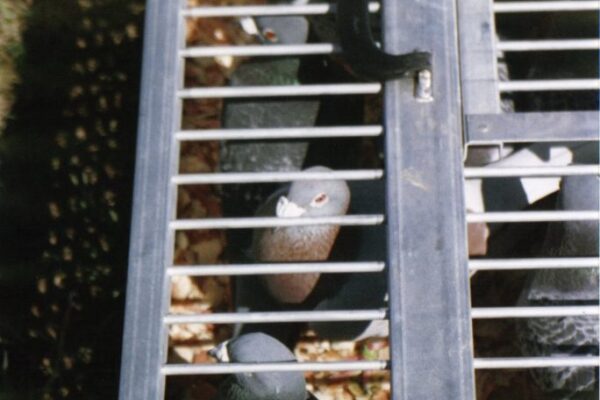

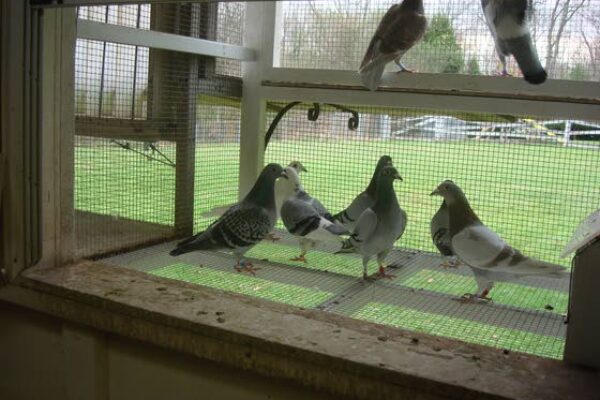

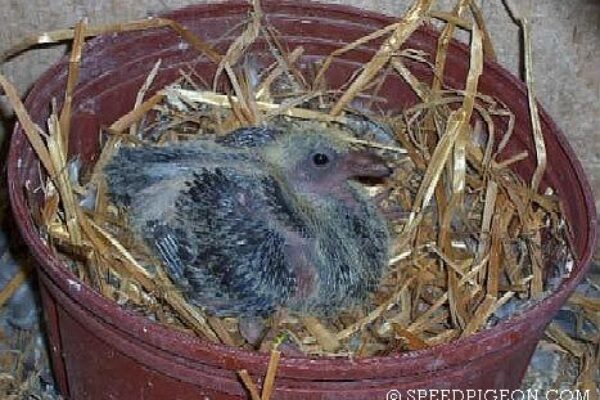
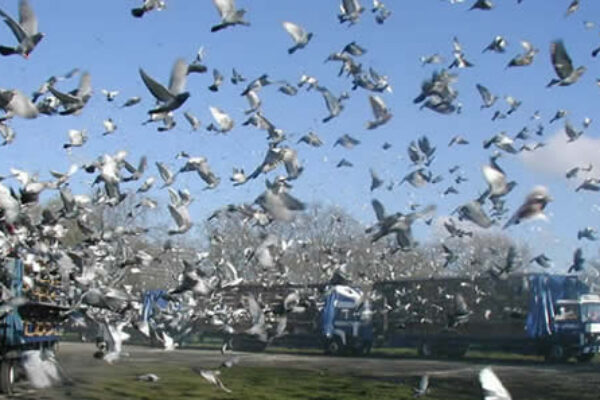


I have a pent roof ,with sky lights with 1 inch vent on the sky light 3 inch back and front at top of the walls and no other vents is this wrong
I live in the state of Hawaii near the rainforest where my annual rainfall can exceed 200 inches per year. My loft has been trial and error but I have come to some very good conclusions’ moisture barrier between the floor joist and subfloor have done wonders’ I have solid wooden plywood flooring my ventilation is located at the lower front with a sliding door 4ft long by 12inces high per loft section with 1/4 inch wire mess, at the roof which is shed style the high end has 2inch aluminum louvers spaced 8 inches apart’ walls were also built using moisture barrier under the siding so my loft is double walled. on each side wall I have vertical wire vents 2feet forward of perches and nest boxes for cross venting’ my nest boxes are standard widowhood with fronts and all other perches are saddle v perches. The air is clean and amazingly dust free as the birds fly within the loft you can see the bloom blowing out the lower vents. Here on this island its not uncommon for the rain to last several weeks during the rainy seasons so its a bit more challenging to find the right balance of oxygen & humidity all year round. I have built several other lofts for others but always keep in mind (Your loft has to be designed for your area)’ no two locations are the same, By trade I’m a custom home builder so a few times I went overboard on designs I saw that ended up being very poor for pigeon health in my area,
Listen guys, when you build your loft or improve it, you must weatherproof the walls and floor with a layer of Visqueen . Polyethylene builders roll, a vapour barrier which costs about £40-00, these rolls are 4 foot wide, and contain about 200 sq feet, If its a new loft build- then place some on the ground first then put your loft on top of it, have it sticking out – sloping into the ground – 2 foot all the way around the loft and held down and covered by gravel at the edges, inside the loft you can staple it to the inner walls and under-roof – *DO NOT COVER THE FLOOR WITH IT-. If you don’t do this then you can forget joining the winners circle. Another thing do not over-do the ventilation, you need a 3/8″ inch slit at the ridge, I said 3/8″ inch, and at the bottom / floor end in each compartment TWO- x 6″ x 1″ inch air gaps, two vents front and rear in each compartment, (each compartment needs a slit vent covered with perforated mesh to keep mice out) Windows need to be glassed in, no dowels or wire mesh, A warm loft is an healthy loft. BOB, k/as Dr Jannssen years ago,
until today I still read all about ventilation and studying it properly and this info help add my knowledge
Some times the wet droppings are caused by the mositure from the ground. The loft is to low and mositure comes in from the ground. I had to have my loft 18 inch above the ground to help. Need good air flow under the loft to help.
hi guys in new zealand the weather is very cold winter and very hot in summer we race birds the young birds in febury in middle of the moult and old birds winter so need to know whats the best way to face my loft. and what type of roof will suit me best.and were must i put the vents.
I also have a question. Say that it rains all week. With proper ventilation, will the droppings still dry properly if the outside weather is constantly humid and wet?
Sir, I have asked questions about ventilation back in April and to date no one answers. The questions are available up above under comments by Nick Demas. Will someone please answer.
Nick Demas
hi guys, new here and in the process of building my loft. i am making a 8x8x8 loft, with a 3 inch drop from the front to the rear. i will not be making a screen down the entire front side. instead i will be making a large avairy in the front, approx. 3x2x2. i am planning on having vents on the door side, and the perch side. none on the nesting side as i hear that its bad to have vents near the nesting boxes. and should i have vents on the aviary side even though i have a large avairy? anyway, i am looking for feedback on the vent placements. is it better to put the vents on the top or the bottom? or on both? i will have flaps on the inside of the loft to block off some of the vents during extreme weather or tempetures if need be. any help would be greatly appreciated. thanks guys.
chris
I’m sick and tired of hearing so many contradictions on ventilation. Some say bottom and top of same wall only, others say bottom front and top rear.This is of course with inclined flat roofs.
With a peak roof air enters through both eaves and out through ridge vents. What about cool air from lower on the wall, or does the air fom the eaves drop to the bottom first.
I just want the best natural system for a flat inclined roof and a peak roof. PLEASE will someone tell the best way. Please respond at mailbox.npd at gmail.com
I will be building two lofts 20’x8’x7′. One with a peak roof and one with a flat roof with a incline.
Thanks Nick
I do not know if anyone has had the courtesy to respond to you…I know the question was posted back in April….but I wanted to give you some suggestions…My family has raised Racing Pigeons since I was a little and I am now in my 40s…so it would be safe to assume I have a “Little Experience”. My loft has an almost flat room. The inclination for the drop is bare minimum so that water does not form a puddle on my roof top…What I have done with my loft is at the top around the edge of the roof…I left a small vent about 1 inch wide and maybe 4 or 5 inches long…And I did this every 4 or 5 feet and Ive covered the vents with mesh to prevent access to rodents. This allows plenty of ventilation without it being too much…I live in Florida and our temperatures do get extreme and constant humidity. I have found that this maintains a very nice comfortable temperature year round. Another thing I did…that has made a tremendous difference for me is…at the very bottom of the front wall of and on the 1 side wall I made an almost ongoing gap about 4 inches in height between the wall board and the floor board….This allows air flow to come in from the very bottom of the loft…(keeping the floor dry) and also making hosing and cleaning out the loft easier…..This may not be how some “EXPERTS” think it should be done but I can tell you is I have very Happy and Healthy Birds. I hope that this information is helpful to you….good luck with your birds.
HOT air rise and Cold air decent we all know that . I try to bring a balance to the loft , hot up and cold down . Stagnated air is the biggest problem in a loft. IT doesn’t matter if the draft comes from top to bottom or from side to side . The intention is to have ample clean air in the lofts . X Cross the vents and it will help to eliminate a draft over the birds .